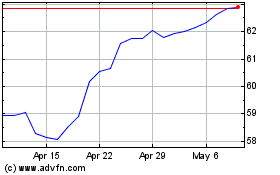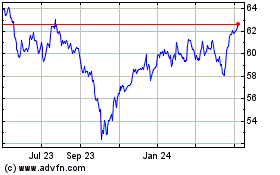Weak global growth, strong U.S. currency raise potential for
disappointing earnings
By Amrith Ramkumar
This article is being republished as part of our daily
reproduction of WSJ.com articles that also appeared in the U.S.
print edition of The Wall Street Journal (February 10, 2020).
Investors worried about the impact of the coronavirus on the
world economy might soon have to confront another challenge to
corporate profits: a strengthening dollar.
The U.S. currency has climbed steadily since the number of
coronavirus cases began surging in China last month, pushing the
WSJ Dollar Index to its highest level since early October. With
many analysts concerned that disruptions to the Chinese economy
will dent global growth, investors have been clinging to U.S.
assets, helping the S&P 500 rebound from its late-January slide
and rise last week to a fresh record.
Although major indexes and the dollar have climbed in tandem,
U.S. companies including Johnson & Johnson, Coca-Cola Co., Ford
Motor Co. and 3M Co. have mentioned the negative effects of
currency swings on earnings calls, highlighting a possible
challenge to the longstanding bull market. A stronger dollar makes
it more expensive for companies to bring home foreign sales and
makes exporters' products less competitive abroad.
Fourth-quarter profits for S&P 500 firms are on track to
stay roughly flat compared with a year earlier, extending a trend
from earlier in 2019. The combination of weak global growth and a
strong dollar raises the possibility that earnings could disappoint
again this year. Any negative impact from the dollar could amplify
the fallout from the coronavirus, which has already forced chains
from Starbucks Corp. to Nike Inc. to close stores in China
temporarily.
Some firms, including McDonald's Corp. and Yum China Holdings
Inc., which operates Pizza Hut and KFC in the country, have already
discussed the uncertain impact of the virus.
"No one knows how this outbreak will play out, and we don't know
how it will ultimately impact us," Royal Caribbean Cruises Ltd.
Chief Executive Richard Fain said on the company's earnings call
last week. The company has already canceled some cruises out of
China.
Analysts expect S&P 500 profit growth to accelerate to 10%
or higher in the last two quarters of 2020, according to FactSet, a
projection that some investors fear will now be hard to hit.
Investors will be monitoring results this week from a group
highlighted by PepsiCo Inc., Cisco Systems Inc. and Nvidia
Corp.
A rising dollar also affects emerging markets and commodities by
making investments denominated in the U.S. currency more expensive
for overseas buyers. Additionally, it becomes more costly for
developing countries to service dollar-denominated debt when the
currency climbs.
Investors have for years expected global economic growth to
weaken the dollar, only for the currency to defy those predictions.
President Trump has consistently criticized the dollar's strength
in recent years, arguing that it places the U.S. at a competitive
disadvantage. He has also cited the dollar in his criticism of the
Federal Reserve, urging the central bank to lower interest rates
further.
The currency's recent advance comes even after three Fed rate
cuts in the last half of 2019, the latest example of sturdy U.S.
growth attracting investors but potentially adding to a murky
earnings backdrop for large companies.
"Expectations might not be met, and that's a market risk," said
Lauren Goodwin, an economist and multiasset portfolio strategist at
New York Life Investments, which holds a smaller position in U.S.
stocks than the benchmark it tracks. "Markets can only defy
fundamentals for so long."
Multinational companies have already been under pressure, with
earnings from S&P 500 firms that get more than half of their
revenue outside the U.S. coming in worse than profits for more
domestically oriented companies for much of last year. Many of
those firms are now contending with the prospect of weaker Chinese
demand and a stronger dollar.
"They're facing a double whammy," said Mona Mahajan, U.S.
investment strategist at Allianz Global Investors, which has been
favoring U.S. stocks and the dollar recently.
The dollar and investments tied to U.S. growth also outpaced
other assets for much of 2019, with analysts worried about trade
tensions. As the new year started, many investors had expected the
trend to reverse following an initial trade deal and clarity on the
U.K.'s exit from the European Union.
Instead, traders are now questioning whether the world economy
can reaccelerate.
"That story is now on hold," said Emily Roland, co-chief
investment strategist at John Hancock Investment Management. "We're
maintaining our preference for the U.S. because it's the best from
an economic growth standpoint."
Still, some analysts don't see the dollar climbing out of its
recent trading range, particularly with the Fed indicating it plans
to leave rates low for now. Many are skeptical that an unforeseen
event such as the coronavirus that boosts the currency temporarily
can provide longer-term support without also threatening economic
growth in the U.S.
But for now, investors have kept buying U.S. assets. The yield
on the benchmark 10-year U.S. Treasury note, which affects
borrowing costs on everything from student debt to auto loans, fell
last week to its lowest level since early October. Yields fall as
bond prices rise.
Traders have also cited a reversal in investor positioning in
explaining the market's recent swings. Net investor bets on a
stronger U.S. currency rose in three consecutive weeks through Feb.
4, after last month hitting their lowest level since 2018,
according to the Commodity Futures Trading Commission and
Scotiabank. The reversal is another example of many betting against
the dollar, only for it to attract investors during turbulent
times.
That bearish positioning "getting beaten out of the market has
been a very consistent theme," said Ed Al-Hussainy, senior
interest-rate and currency analyst at Columbia Threadneedle
Investments. "The safe-haven narrative is absolutely critical."
Write to Amrith Ramkumar at amrith.ramkumar@wsj.com
(END) Dow Jones Newswires
February 10, 2020 02:47 ET (07:47 GMT)
Copyright (c) 2020 Dow Jones & Company, Inc.
Coca Cola (NYSE:KO)
Historical Stock Chart
From Mar 2024 to Apr 2024

Coca Cola (NYSE:KO)
Historical Stock Chart
From Apr 2023 to Apr 2024
